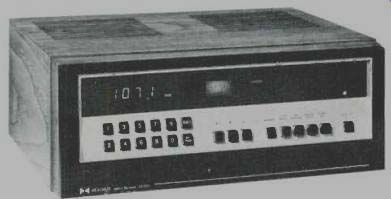
MANUFACTURER'S SPECIFICATIONS
MONOPHONIC PERFORMANCE. IHF Sensitivity: Less than 1.8 µV. Alternate Channel Selectivity: Greater than 95 dB. Capture Ratio: Less than 1.5 dB. Harmonic Distortion: Less than 0.3%. IM Distortion: Less than 0 1%. S/N Ratio: Greater than 65 dB. Image Rejection: Greater than 95 dB. I.f. Rejection: Greater than 95 dB. Spurious Rejection: Greater than 95 dB. AM Suppression: Greater than 50 dB. Channel Frequency Accuracy: Better than 0.005%. Frequency Response: 20 to 1 5,000 Hz +1 dB.
STEREOPHONIC PERFORMANCE. Channel Separation: 1000 Hz, 40 dB; 80 Hz, 25 dB; 10 kHz, 25 dB; 15 kHz, 20 dB. Harmonic Distortion: Less than 0.35%. Frequency Response: 20 to 15,000 Hz ±1 dB. 19 kHz and 38 kHz Suppression: Greater than 55 dB. SCA Suppression: Greater than 55 dB.
GENERAL SPECIFICATIONS. Output Voltage: 1.2 volts nominal (at 100% modulation). Output Impedance: 4700 ohms.
Power Requirements: 105-125 or 210-250 volts, 50/60 Hz a.c.; 50 watts maximum.
Overall Dimensions: 16 3/8 in. W., 6 in. H., 14 3/4 in. D.
Net Weight: 15 3/4 lbs.
Suggested Retail Price: $ 539.95, kit; optional pecan wood cabinet, $24.95.
Every decade or so, since the introduction of FM broadcasting on a commercial basis some 30 years ago, there comes upon the market a tuner which is destined to become "classic." Those of us who remember that far back will forget the old REL Precedent tuner which is [...] doing yeomen's duty as a monitor tuner in many a broadcast studio throughout the country.
The tuner which may well prove to be the "classic" of the 1970's is Heath's new AJ-1510 Digital FM Stereo Tuner. There is so much that's new and unique in this model that it would take a small volume to fully do it justice. (As a matter of fact, just about half of Heath's excellent 233 page manual is devoted to an excellent exposition of just what makes this unit tick.) We were privileged to have in our possession "Final Engineering Prototype #1"-well in advance of its announced distribution as an available model and, frankly, we intend to hold on to it until the Heath Company starts sending nasty dunning letters-it's that hard to part with it. The "ultimate" tuner? Well, if it isn't, it'll do until someone comes up with something better!
The front panel layout of the M-1510 is like no other tuner you've ever seen. It is of black and gold material and has a very "quiet" but elegant look to it. There is NO tuning knob and there is NO tuning dial or pointer, since all frequency indications are read from digital read-out tubes located at the upper left of the panel. The upper center of the panel contains a signal strength meter which also doubles as a multipath indicator and the upper right portion of the panel is devoted to such visual read-outs as STEREO, REPROGRAM notations and notations regarding the sometime UNLOCKED status of the frequency synthesizer, about which more in a moment. The middle area of the panel is the section with which the user will be most involved. At the left are ten keyboard buttons, numbered "1" through "0," as well as a re-set button (punched when you wish to "punch up" a new station frequency) and a button labeled BYPASS (used to initiate the "auto-sweep" action which causes the tuner to sweep downward in frequency, automatically locking in on every available signal in your area).
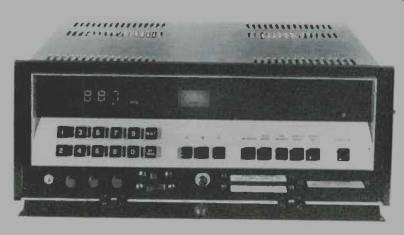
Fig. 1--Front of AJ-1510 with trap door panel opened.
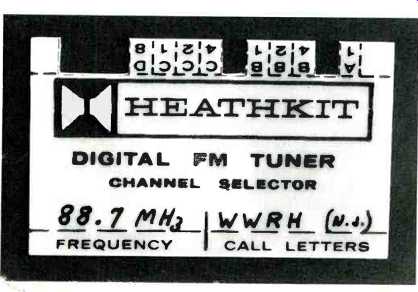
Fig. 2—Program card
At the center of the panel are three more buttons, labeled A, B and c. These are used to select three predetermined favorite stations. The buttons located at the right section of the center of the panel select KEYBOARD, AUTO-SWEEP, or PRE-PROGRAMMED mode of tuning, and there are additional buttons for SQUELCH DEFEAT and STEREO ONLY reception. If the STEREO ONLY button is depressed, only stations transmitting a stereo signal will be heard, regardless of which of the three tuning methods is in use. Finally, a matching power ON-OFF button completes this portion of the panel layout.
If you press gently upon the lower portion of the panel, this portion springs open to disclose some additional controls which are ordinarily used rather infrequently. These include a tiny test switch button which, when depressed, lights up all the elements of the digital readout tubes to insure that they are operative. There is also a rotary control which determines the speed at which the AUTO-TUNE action takes place, a noise squelch adjustment control, and an AGC C squelch control.
A slide switch changes the meter function from signal strength indication to multi-path indication and a second, three-position slide switch selects automatic stereo, partial stereo blend (for reduced noise in weak-signal stereo reception situations with some sacrifice in overall stereo separation, and mono-mix.
The right section behind the trap door contains three horizontal slots, labeled A, B and c. These slots correspond to the three PRE-PROGRAM selection buttons described earlier and, upon inserting three plastic cards no larger than a standard credit card, the buttons can be used to tune in your favorite stations which you easily program onto the cards yourself.
One of these cards is illustrated in Fig. 2 and, as you can see, it is notched to select a specific frequency. Heath supplied us with about a dozen of these cards so you're really not limited to just three preselected favorite stations, but can insert other cards in the three slots as you see fit.
The rear panel of the AJ-1510 is pictured in Fig. 3 and contains antenna terminals for 300 ohm or 75 ohm transmission lines, a dual pair of output jacks as well as horizontal and vertical output jacks for connection to an oscilloscope for observing the nature and extent of any local multipath problems beyond what you can read on the dual purpose self-contained signal meter. A 0.5 amp fuse holder and an unswitched convenience a.c. receptacle complete the back panel layout.
While the unit supplied to us was fully wired, we were able to appreciate the amount of thoughtful engineering that went into this unit, both in terms of its performance as well as its kit feasibility. Recent Heathkits have increasingly stressed the modular approach and the AJ-1510 has carried this concept to its ultimate. There is a "master" or "mother" board into which are plugged seven circuit boards. Connectors are used throughout, which means that boards can be removed without having to unsolder or unwire a single connection. The keyboard p.c. module and the readout circuit board are mounted separately up against the inside of the front panel. An open view of the assembled chassis is shown in Fig. 3. The names of the seven major modules will give you a clue as to the sophistication inherent in this circuitry. They are: Tuner/ Phase-Lock-Loop Circuit Board, Generator-Divider-Oscillator Board, Programmer Board, Preload Decoder Circuit Board, I.f. Circuit Board, Multiplex Circuit Board, and Power Supply Board.
The heart of the non-mechanical tuning aspect of this unit lies in the voltage-tuned FM front-end, which is of the varactor-tuned type and contains no moving variable capacitor.
Instead, a suitable d.c. voltage applied to the varactor diodes determines their effective capacitance. The keyboard, preprogrammed cards, or automatic sweep tuning methods all program a divider circuit. The divider circuit divides the tuner's local oscillator frequency and compares it to a crystal controlled reference frequency and the result of this comparison is the tuning voltage. Changing the divide ratio of the divider circuit changes the d.c. voltage applied to the tuner and a different station is tuned in. Simultaneously, a visual display of the station frequency is provided by the readout circuitry. Because of the crystal controlled reference frequency and the phase-lock-loop circuitry, however, the accuracy of the frequency tuned in is no longer dependent upon the drift free characteristics of the FM front-end but will be as accurate as the reference crystal frequency and, in the case of the AJ1510, that means at least 0.005% accuracy! Translated to frequency, that means a maximum error of no more than 5 kHz at a frequency of 100 MHz and that is not considered a significant error by anyone's standards.
Do not confuse this "digital readout" tuner with some units which have recently appeared on the market and simply replace the tuning dial with numeric readout devices. The latter variety guarantee no more tuning accuracy than their "dial pointer" counterparts. The Heath AJ-1510 is tuned exactly to 101.5 MHz when those readout tubes READ 101.5-and not to 101.54 or 101.47!

Fig. 3--Rear panel of the AJ-1510 also showing modular circuit board
construction.
Performance Measurements
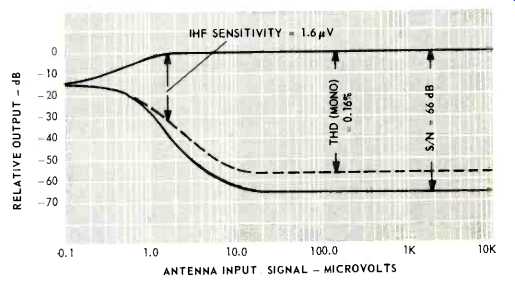
Fig. 4--Mono FM characteristics.
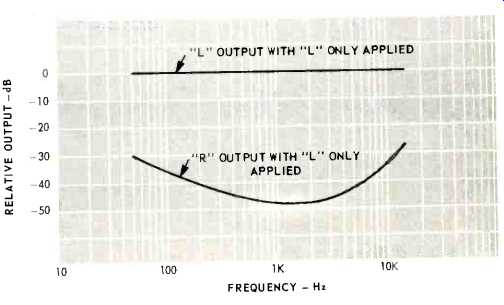
Fig. 5.--Stereo FM performance.
There is no doubt that the elaborate "computer" type circuitry incorporated in the Heath AJ-1510 must represent a fair percentage of its selling price, but even if you ignored it completely (or considered it as a welcome bonus), the tuner's performance as a tuner would justify its total price and then some. Normally, when we try to measure IHF sensitivity in our location, we usually try to pick frequencies which do not correspond to actual FM channels. Thus, for low end measurements, we often go down to 87.9 or 88.0 where there are no measurement we try possible channels and for the mid-band for an even number such as 98.0 or 98.2. Almost as if to reprimand us, when we punched up 87.9 MHz on the keyboard, a light lit up on the front panel and read REPROGRAM. (It could have said "please"....) Realizing that we weren't about to fool this unit, we settled for 88.3, 98.9 and 106.1. These chosen frequencies, together with our not-too-perfect "screen room" enabled us to read a sensitivity of 1.6 µV. Impressed, we decided that we weren't going to let this one get off so easily, so we tried to measure alternate channel selectivity and, as near as we could figure, it was just about 100 dB! The total quieting curve is shown in Fig. 4 and, along with it, you can interpolate the THD (mono) down to an incredible 0.18% for 100% modulation (as opposed to 0.3% claimed). Ultimate S/N is a very respectable 66 dB. Note, too, that quieting reaches a very usable 56 dB with a mere 5 µV of signal input.
In the stereo mode, we re-measured the THD and found that it was only 0.25% for 100% modulation (as against 0.35% claimed) and that, to us, represents a real breakthrough, since stereo THD is usually much higher than mono THD on most tuners and receivers we have measured in the past.
The stereo separation characteristics of the AJ-1510 are graphed in Fig. 5 and, again, the very conservatively stated published specifications are exceeded. Here's a tuner that maintains at least 30 dB of separation from 50 Hz to 14 kHz and hits a mid-band separation figure of 46 dB! Both SCA and 19 and 38 kHz suppression were in excess of 60 dB, which means that SCA interference was absolutely inaudible. Capture ratio measured 1.35 dB as against 1.5 dB claimed. Our generator is only capable of measuring spurious responses up to 90 dB and since we couldn't detect any we'll have to say that Heath more than likely meets its 95 dB spec here too.
In short, every spec was easily met or exceeded and if you compare published specs with the best of the "ready mades," you're not likely to come up with a finer set of readings anywhere. All through these measurements I had a hard time keeping in mind that the AJ-1510 is a tuner "kit"-you put it together yourself and realize these kinds of performance specs! Listening Tests After spending several hours playing with the keyboard, the automatic sweep, and the dozen or so cards which I prepared with the aid of a small pair of scissors, I got down to the serious business of logging stations. The automatic sweep mode proved best suited to this task, since all I had to do was sit there and punch the BYPASS button and watch the digits read down from 107.9. For these tests, the squelch control was reduced to its minimum setting. Normally, this control would be adjusted so that only stations having a desired quieting level or better would be allowed through, but I wanted to get a count of as many stations as I could. Would you believe 63, without having to rotate my antenna? Of these, I might have "rejected" about 7 or so as being too noisy, but that still leaves 56 listenable stations. I repeated the experiment with the stereo-only button depressed and came up with an impressive 32 stations, of which 5 were a bit too noisy. (One of the five was located at a known distance of 85 miles from my location.) We also experimented with the MULTIPATII function of the signal meter and found (with the aid of a 'scope) that when it showed a null (as we rotated our outdoor antenna), the multi path (as shown on the 'scope) was truly at its minimum point.
Incidentally, in using the AUTOMATIC SWEEP method of tuning, if you keep the BYPASS button depressed you do not hear undesired stations as the read-out sweeps down from 107.9 to 88.1. Stations only "lock in" and become audible when you release the bypass button. Even if you adjust the "speed" of the automatic sweep sequence to its maximum, the stations will lock in accurately, without skipping, providing your own reaction time gets your finger off that button on time. For less agile fingers, the speed can be reduced to about one channel-width per second, which is slow enough for anyone's needs.
We enjoyed the crystal-clear, distortion-free reception we obtained in using the Heath AJ-1510, and we were always ware of the fine performance specs while using it. But perhaps the most gratifying thing about using the AJ-1510 is he certain knowledge that no matter what station we were tuned to the frequency to which the unit was tuned was "right on." Even the best calibrated dial is subject to visual interpretation and even the finest center-of-channel meters are not always perfectly balanced or calibrated-but that phase-lock loop comparator circuit of the Heath AJ-1510 has got to be the way all tuners of the future will be made. It's very nice to now that Heath has just brought that future into the present.
In a way, we're sorry our unit came completely wired. Can you imagine what we would have thought about this much performance in a tuner if we had actually wired it ourselves?
-Leonard Feldman
(Audio magazine, May 1972)
Also see:
Heath AJ-2520 Tuner (Mar. 1990)
Hafler Iris FM Tuner (Feb. 1990)
Nikko Gamma I Stereo FM Tuner (May 1979)
Onkyo T-9090II FM Tuner (Jul. 1988)
Optonica ST-3636 AM/FM Stereo Tuner (Dec. 1978)
McIntosh Model MR-78 FM/Stereo, FM Tuner (Feb. 1977)
= = = =